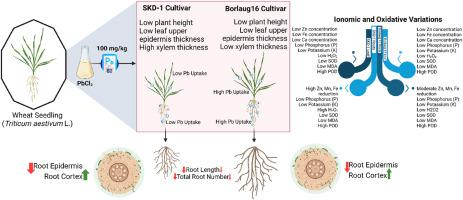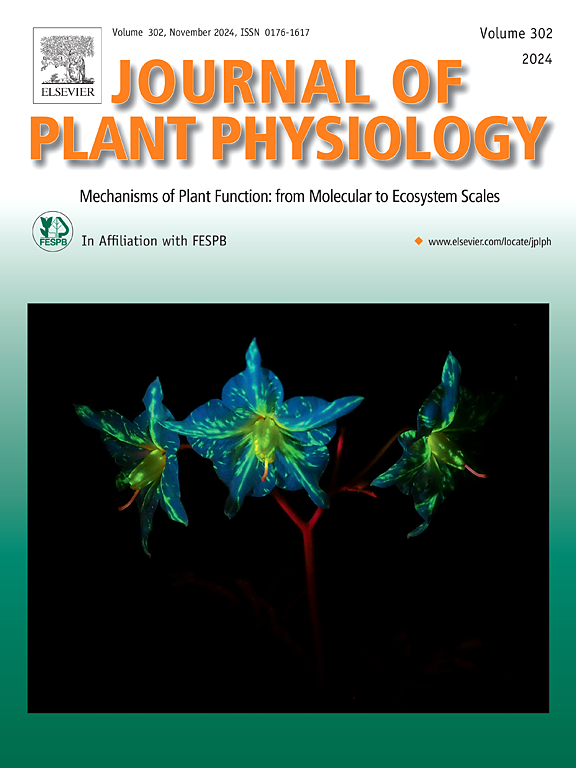Adaptive mechanisms of wheat cultivars to lead toxicity through enhanced oxidative defense, ionomic redistribution, and anatomical modifications
IF 4
3区 生物学
Q1 PLANT SCIENCES
引用次数: 0
Abstract
Lead (Pb) contamination is a critical environmental issue that poses a substantial threat to agricultural sustainability and crop productivity, particularly for staple crops like wheat (Triticum aestivum L.). This study investigates the differential physiological, biochemical, and anatomical responses of two wheat cultivars, SKD-1 and Borlaug-16, under Pb stress (100 mg/kg Pb for 21 days). Borlaug-16 displayed a notable tolerance to Pb toxicity, evidenced by a significant increase in total biomass, including a 41.22% rise in shoot turgid weight and a 23.37% increase in root turgid weight, alongside a 57.72% enhancement in root cortex thickness. This cultivar also showed increased antioxidant enzyme activities, such as catalase and peroxidase, and a better ionomic balance, maintaining higher levels of essential minerals like Ca in leaf tissues while effectively accumulating Pb and other trace elements in roots. In contrast, SKD-1 suffered from a more substantial reduction in essential minerals and weaker anatomical and biochemical defenses. The study's novelty lies in providing an integrated approach to understanding wheat cultivar-specific adaptations to Pb stress, suggesting Borlaug-16 as a promising candidate for cultivation in Pb-contaminated soils. These findings underscore the importance of developing Pb-tolerant cultivars to ensure sustainable wheat production in polluted environments.

小麦栽培品种通过增强氧化防御、离子重新分布和解剖结构调整对铅毒性的适应机制。
铅(Pb)污染是一个严重的环境问题,对农业可持续发展和作物生产力构成了巨大威胁,尤其是对小麦(Triticum aestivum L.)等主要作物而言。本研究调查了 SKD-1 和 Borlaug-16 这两个小麦品种在铅胁迫(100 毫克/千克铅,21 天)下的不同生理、生化和解剖反应。Borlaug-16 对铅的毒性表现出明显的耐受性,表现在总生物量显著增加,包括芽的隆起重增加了 41.22%,根的隆起重增加了 23.37%,根皮层厚度增加了 57.72%。该栽培品种的过氧化氢酶和过氧化物酶等抗氧化酶活性也有所提高,离子平衡性更好,叶片组织中钙等必需矿物质的含量较高,而根系中铅和其他微量元素的含量也有效提高。相比之下,SKD-1 的必需矿物质含量大幅减少,解剖和生化防御能力较弱。这项研究的新颖之处在于提供了一种综合方法来了解小麦栽培品种对铅胁迫的特异性适应性,并建议将 Borlaug-16 作为在铅污染土壤中种植的一个有前途的候选品种。这些发现强调了开发耐铅栽培品种以确保污染环境中小麦可持续生产的重要性。
本文章由计算机程序翻译,如有差异,请以英文原文为准。
求助全文
约1分钟内获得全文
求助全文
来源期刊

Journal of plant physiology
生物-植物科学
CiteScore
7.20
自引率
4.70%
发文量
196
审稿时长
32 days
期刊介绍:
The Journal of Plant Physiology is a broad-spectrum journal that welcomes high-quality submissions in all major areas of plant physiology, including plant biochemistry, functional biotechnology, computational and synthetic plant biology, growth and development, photosynthesis and respiration, transport and translocation, plant-microbe interactions, biotic and abiotic stress. Studies are welcome at all levels of integration ranging from molecules and cells to organisms and their environments and are expected to use state-of-the-art methodologies. Pure gene expression studies are not within the focus of our journal. To be considered for publication, papers must significantly contribute to the mechanistic understanding of physiological processes, and not be merely descriptive, or confirmatory of previous results. We encourage the submission of papers that explore the physiology of non-model as well as accepted model species and those that bridge basic and applied research. For instance, studies on agricultural plants that show new physiological mechanisms to improve agricultural efficiency are welcome. Studies performed under uncontrolled situations (e.g. field conditions) not providing mechanistic insight will not be considered for publication.
The Journal of Plant Physiology publishes several types of articles: Original Research Articles, Reviews, Perspectives Articles, and Short Communications. Reviews and Perspectives will be solicited by the Editors; unsolicited reviews are also welcome but only from authors with a strong track record in the field of the review. Original research papers comprise the majority of published contributions.
 求助内容:
求助内容: 应助结果提醒方式:
应助结果提醒方式:


